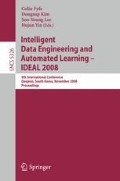Abstract
We study averaging schemes that are specifically adapted to the analysis of electroencephalographic data for the purpose of interpreting temporal information from single trials. We find that a natural assumption about processing speed in the subjects yields a complex but nevertheless robust algorithm for the analysis of electrophysiological data.
Access this chapter
Tax calculation will be finalised at checkout
Purchases are for personal use only
Preview
Unable to display preview. Download preview PDF.
References
Flexer, A.: Data mining and electroencephalography. Stat. Meth. Medical Res. 9, 395 (2000)
Woody, C.D.: Characterization of an adaptive filter for the analysis of variable latency neuroelectric signals. Medical and Biological Engineering and Computing 5, 539–553 (1967)
Picton, T.W., Lins, O.G., Scherg, M.: The recording and analysis of event-related potentials. In: Boller, F., Grafman, J. (eds.) Handbook of Neuropsychology, pp. 3–73. Elsevier, Amsterdam (1995)
Gibbons, H., Stahl, J.: Response-time corrected averaging of event-related potentials. Clinical Neurophysiology 118, 197–208 (2007)
Schrobsdorff, H., Ihrke, M., Kabisch, B., Behrendt, J., Hasselhorn, M., Herrmann, J.M.: A Computational Approach to Negative Priming. Connection Science 19(3), 203–221 (2007)
Ihrke, M.: Negative priming and response-relation: Behavioral and electroencephalographic correlates. Master’s thesis, U. Göttingen (2007), http://www.psych.uni-goettingen.de/home/ihrke
Haig, A.R., Gordon, E., Rogers, G., Anderson, J.: Classification of single-trial ERP sub-types. Electroencephalogry Clinical Neurophysiology 94(4), 288–297 (1995)
Truccolo, W.A., Ding, M., Knuth, K.H., Nakamura, R., Bressler, S.L.: Trial-to-trial variability of cortical evoked responses. Clinical Neurophysiology 113(2), 206–226 (2002)
de Weerd, J.P.: A posteriori time-varying filtering of averaged evoked potentials. I. Introduction and conceptual basis. Biological Cybernetics 41(3), 211–222 (1981)
Nagelkerke, N.J.D., Strackee, J.: Some notes on the statistical properties of a posteriori Wiener filtering. Biological Cybernetics 33(2), 121–123 (1979)
Truccolo, W.A., Ding, M., Bressler, S.L.: Variability and interdependence of local field potentials. Neurocomputing 38(40), 983–992 (2001)
Ciganek, L.: Variability of the human visual evoked potential: normative data. Electroencephalogr. Clin Neurophysiol. 27(1), 35–42 (1969)
Basar, E., Gonder, A., Ozesmi, C., Ungan, P.: Dynamics of brain rhythmic and evoked potentials. Biological Cybernetics 20(3-4), 137–143 (1975)
Lange, D.H., Siegelmann, H.T., Pratt, H., Inbar, G.F.: Overcoming selective ensemble averaging: unsupervised identification of event-related brain potentials. IEEE Transactions on Biomedical Engineering 47(6), 822–826 (2000)
Tibshirani, R., Walther, G., Hastie, T.: Estimating the number of clusters in a data set via the gap statistic. Journal of the Royal Statistical Society: Series B 63(2), 411–423 (2001)
Woldorff, M.G.: Distortion of erp averages due to overlap from temporally adjacent erps: Analysis and correction. Psychophysiology 30, 98–119 (1993)
Myers, C., Rabiner, L.: A level building dynamic time warping algorithm for connected word recognition. IEEE Transact. Acoustics, Speech, and Signal Proc. 29, 284–297 (1981)
Keogh, E.J., Pazzani, M.J.: Derivative Dynamic Time Warping. In: First SIAM International Conference on Data Mining (SDM 2001) (2001)
Author information
Authors and Affiliations
Editor information
Editors and Affiliations
Rights and permissions
Copyright information
© 2008 Springer-Verlag Berlin Heidelberg
About this paper
Cite this paper
Ihrke, M., Schrobsdorff, H., Herrmann, J.M. (2008). Compensation for Speed-of-Processing Effects in EEG-Data Analysis. In: Fyfe, C., Kim, D., Lee, SY., Yin, H. (eds) Intelligent Data Engineering and Automated Learning – IDEAL 2008. IDEAL 2008. Lecture Notes in Computer Science, vol 5326. Springer, Berlin, Heidelberg. https://doi.org/10.1007/978-3-540-88906-9_45
Download citation
DOI: https://doi.org/10.1007/978-3-540-88906-9_45
Publisher Name: Springer, Berlin, Heidelberg
Print ISBN: 978-3-540-88905-2
Online ISBN: 978-3-540-88906-9
eBook Packages: Computer ScienceComputer Science (R0)

